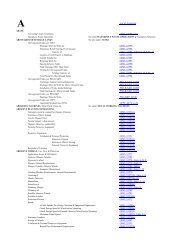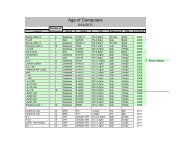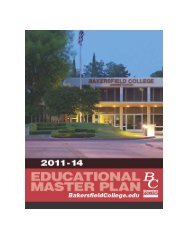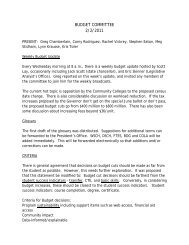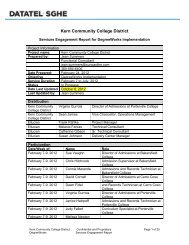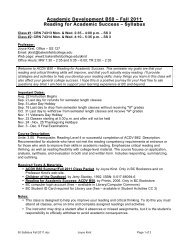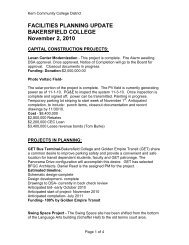Addendum with evidence (8.2 MB) - Accreditation - Bakersfield ...
Addendum with evidence (8.2 MB) - Accreditation - Bakersfield ...
Addendum with evidence (8.2 MB) - Accreditation - Bakersfield ...
You also want an ePaper? Increase the reach of your titles
YUMPU automatically turns print PDFs into web optimized ePapers that Google loves.
The Force Complete exception can be used on any course rule and most<br />
qualifiers and is the only exception type that may be used on a percentage<br />
rule (i.e. GPA rules). This exception type is completely independent of all<br />
student data. It will simply complete a rule on a student degree audit<br />
regardless of any applied qualifiers. Forcing a rule/qualifier complete tells the<br />
auditor to ignore the rule/qualifier the next time and audit is performed for this<br />
student.<br />
Note: Functionally, this is the most powerful exception and should be used<br />
<strong>with</strong> caution. Often use of this exception <strong>with</strong> require the use of one or more<br />
additional exceptions. Example: If a student is exempted from completing a<br />
3 credit course but the block requires 40 total credits, either a second<br />
exception to reduce the number of credits required to 37 needs to be made or<br />
an additional class needs to be required on a different rule <strong>with</strong>in that block to<br />
make up the course waived.<br />
o Substitute – allows you to substitute one course for another. This option<br />
may be used either before or after the alternate course is taken and may be<br />
used multiple times on the same rule. This will completely remove one<br />
course from the options available to the student and replace it <strong>with</strong> another,<br />
however, you may wish to consider using the Also Allow exception type<br />
instead (see description below) due to its additional functionality. An example<br />
of when this option is appropriate would be for a student who (for whatever<br />
reason – example: having completed most of the coursework at another<br />
institution but not received equivalency credit) should never take the original<br />
class but should take another instead.<br />
o Also Allow – appends courses to a course list on a rule. This option may be<br />
used either before or after the alternate course is taken and may be used<br />
multiple times on the same rule. This exception can be used when you wish<br />
to expand the course options available for a specific rule. In many instances<br />
this is a better option that using the Substitute exception for two reasons:<br />
The original class is still an option for the student and does not require<br />
reversal of the exception should the student change their mind about<br />
using the approved alternate course, thus allowing the auditor engine<br />
the most options for moving the student as close to graduation as<br />
possible.<br />
Additional qualifiers can be added to the additional course (i.e. a<br />
minimum grade may be required, must be taken after a certain term, a<br />
specific title for a special topics course, etc.)<br />
Additionally, this is the rule of choice for identifying courses that need to<br />
be taken when the audit indicates that they advisor must approve the<br />
courses that will satisfy the rule.<br />
Limitations:<br />
1) Courses applied using the Also Allow exception are still subject to<br />
header qualifiers in the blocks in which they are used and are still subject<br />
to the best-fit algorithm. Example: An Also Allow exception is processed<br />
allowing ENGL 215 to be used to satisfy a course rule and there is a<br />
Kern Community College District Confidential and Proprietary Page 10 of 20<br />
DegreeWorks Services Engagement Report



